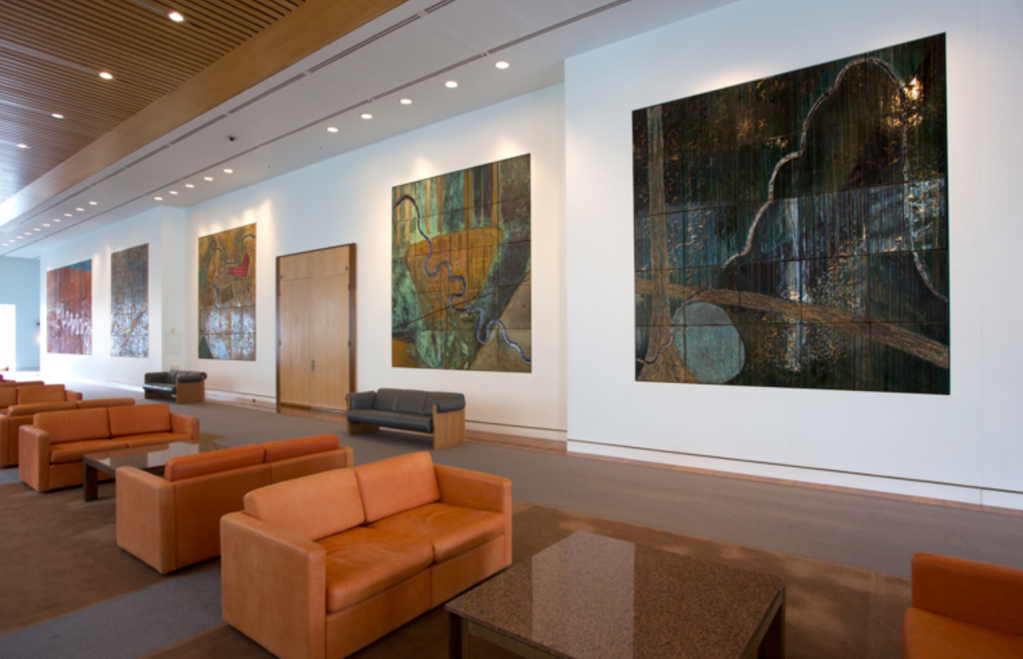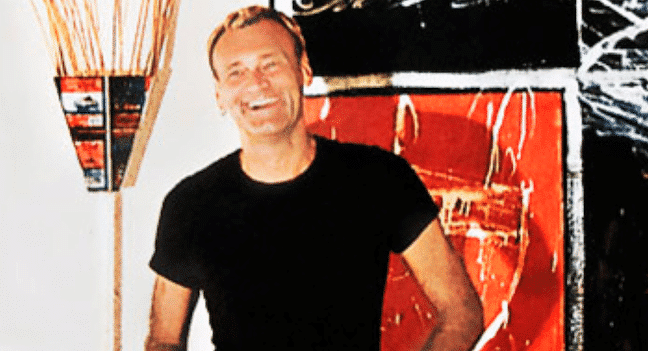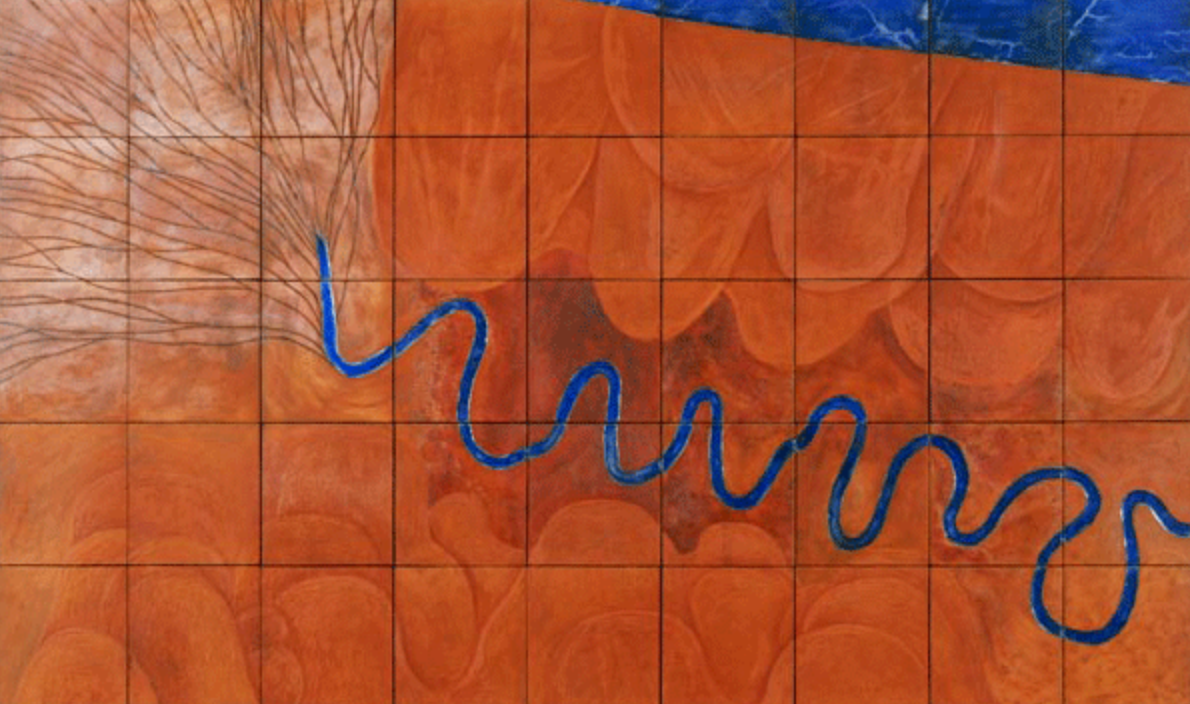Born in the northern suburbs of Wollonong (coastal NSW), Graham Oldroyd (1953-2022) was a highly regarded and influential ceramicist and painter. He passed away this weekend at his home in Perth.
While he is perhaps most popularly known for his large ceramic mural in the Members Hall of new Parliament House, Canberra, he also had a passion for teaching, for research, for glazes and travel.
Oldroyd was commissioned, with painter Michael Ramsden, to make the expansive mural – comprised of six separate multi-panelled works – for the opening of the Parliament House in 1986-7 (the artists were big fans of Gough Whitlam and asked him to add his initials while they were completing the work).
At the time Oldroyd was working a lot in the architectural field, pushing the use of ceramics in interesting ways. Friend and author, Wendy Walsh (nee Jolliffe) said of the commission: ‘Graham embarked on a year of glaze experiments which were used for the beautiful series of ceramic panels.
‘I often watch the evening news on TV marvelling at politicians being interviewed … they stand in front of the magnificent ceramic mural called Six River Odyssey by Graham and painter Michael Ramsden. This important legacy will be viewed by Australians sitting in their loungerooms watching the news for probably the next hundred years.’

Walsh added: ‘Graham’s stature in the art world is undeniable … (his) artistic passion for technical experimentation in clay and glaze is a testament seen in an oeuvre of superb, often sculptural, creations.’
It was a view shared by Museum of Applied Arts and Sciences (MAAS) Curator Eva Czernis-Ryl. She described Gra (as he signed his emails) as ‘very kind, open and generous, although I knew that he found it difficult to talk about his work.’
Simon Bowley, our Sturt potter-in-residence added Oldroyd was, ‘as an inspiring teacher and innovative ceramicist who used materials in untraditional ways.’
Czernis-Ryl spoke of Oldroyd’s passion for glazes, and a conversation she had with the artist as she prepared for the recent exhibition Clay Dynasty at the Powerhouse Museum, where Oldroyd’s work was part of a survey charting 50 years of studio ceramic practice in Australia.

Czernis-Ryl continued: ‘It is only a couple of months ago that we talked at length and corresponded about his beautiful copper-red glazed bottles, one of which is on display in the Clay Dynasty exhibition… Oldroyd talked about his love for Islamic ceramics, he reminisced: “…When l was 17, l saw that Alan Peascod was giving a demonstration at a local fete in Wollongong and l went along. I watched him for hours and at the end when he was packing up l asked if he could teach me. He said yes. Two years after that Alan, his fabulous wife Jean, and me were traveling through the Middle East.”
‘Oldroyd added: “My fascination for lustre took me later on several trips to Egypt and I got to work with Said El-Sadr in Cairo in his studio in Fostat.”
Walsh said of that love to share his passion of Egyptian ceramics: ‘In the 1970s he gifted me Egyptian faience scarabs and ushabti dolls from his sojourns studying ceramics in Cairo. During a trip to Italy in 1980 I witnessed firsthand his love of all things made of earth – from Etruscan artefacts, Italian Renaissance majolica-ware, to Islamic pots of lustre.’
Czernis-Ryl continued: ‘His personal work was to reinvent lost Islamic glaze traditions in Egypt. [And] as a teacher, Oldroyd passed on his passion for ceramics and Islamic arts to generations of students. His passing is a profound loss to the ceramic community.’
Read: Vale to ceramicist Merran Esson
Less spoken about is Oldroyd’s passion also for painting. In many ways that brushy, gestural aspect of applying glaze punched beyond the vessel. There was a clear link across his practices.
Who was Graham Oldroyd?
From 1972-73, Oldroyd studied ceramics at East Sydney Technical College (ESTC, later known at the National Art School) under the late Peter Rushforth (1920-2015). He also studied at Sturt Pottery in Mittagong, and the Canberra School of Art during this period.
This is when he started his research interest in Islamic ceramic forms and experimental glazes, travelling to Egypt, Iraq and Turkey.
In 1975, he set up a studio at Wombarra, in the northern reaches of the Illawarra. In 1977 he began lecturing at ESTC, becoming Head of Ceramics from 1980-1984.
During this time (1981), he was awarded a Research Scholarship to study Islamic Glaze and Ceramics with Said El Sadr in Cairo, and in 1984 was invited as Overseas Guest Lecturer at Camberwell School of Art, London.
From 1985-86, Oldroyd moved into the position of Head of the Ceramics Division for TAFE NSW. But his focus then shifted.
In 1988, he set up a partnership with Philip Lakeman under the name Lakeman Oldroyd Architectural Ceramics, working on architectural commissions in Asia over a number of years through to 1993.
That eventually transitioned to the Pesamuan Ceramic Studio as lead designer in 1995-97, headquartered in Bali (Indonesia), and he remained involved with the business, specialising in ceramic tiles, as a company director up until his death.
Oldroyd’s works are held in the collections of the Victoria and Albert Museum London, Art Gallery of Western Australia, Artbank, Powerhouse Museum, Australian Embassy Cairo, Hota (formerly the Gold Coast Regional Art Gallery), Manly Art Gallery, Wollongong Art Gallery, among others.
Additional to Parliament House, major commissions for hotels in Singapore, Bali, Jakarta, among other corporate buildings ensure Oldroyd’s ceramics had maximum exposure.
Oldroyd ‘retired’ to Bali in 2013, but relocated back to Australia in 2018, to Perth with his partner Atmoko Sapto. He continued to draw and paint up to his death.





